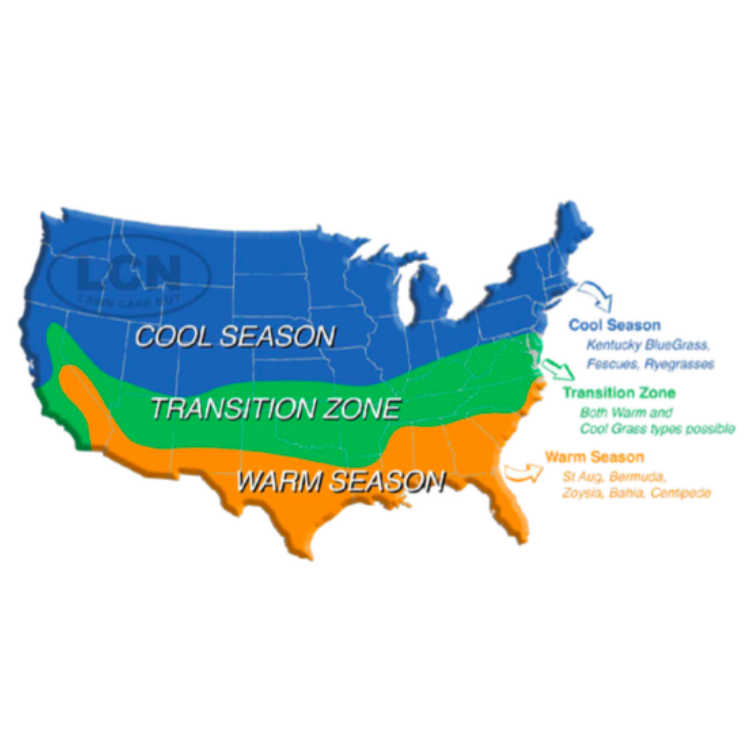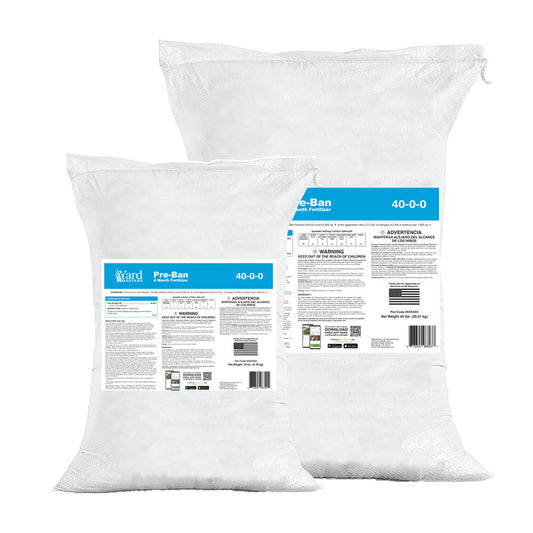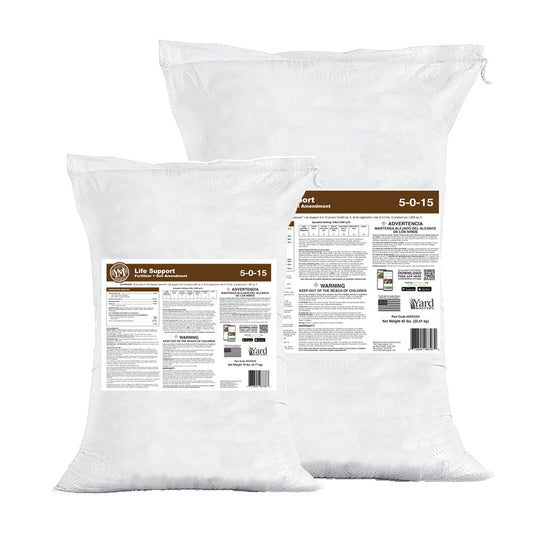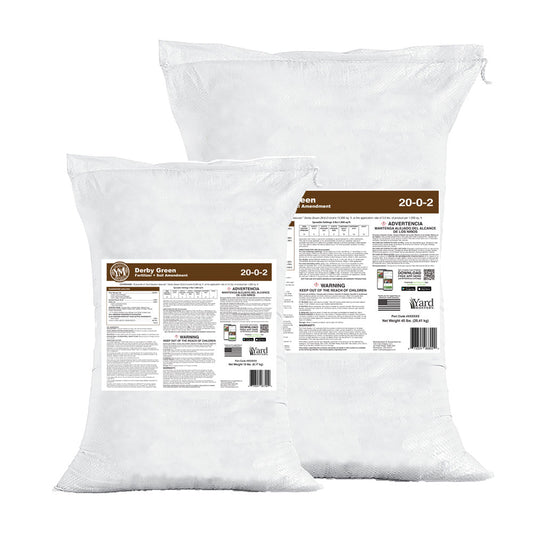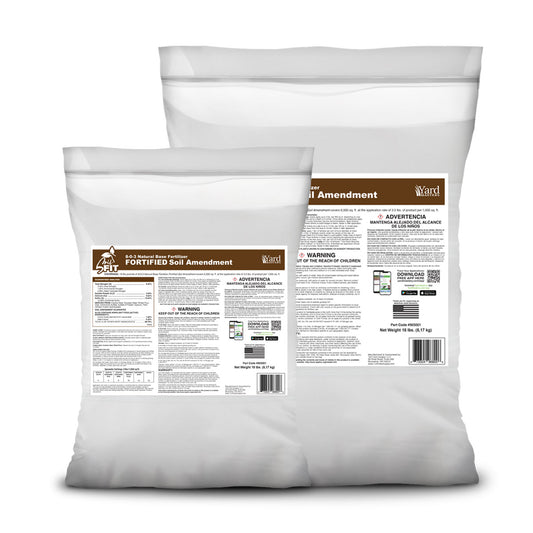If you are looking for the best lawn fertilizer for summer, this is the place to start. I give you the straight talk on what summer fertilizer to apply to each grass type and why.
Looking for a way to track your fertilizer usage? Get our free lawn app (iPhone or Android) where you can keep notes and even upload pics of your lawn all along the way.
This is going to be a 2-part series. The first part below is going to talk about how your lawn will respond to summer stress depending upon grass type, as well as give you 2 “store bought” summer fertilizer recommendations, and then the second part will later this week and will give you some more “funky fresh” options that we have available in our stores.
What Is Lawn Fertilizer?
Here I am talking about products that only contain nutrients or soil amendments. Those being N-P-K and/or micronutrients and carbon or bio-stimulants. We are not talking about “weed and feeds” which contain fertilizer + weed control, or other dual use products. It’s important to understand that “fertilizer” is just nutrients and amendments for the lawn. If you need to kill weeds, bugs or fungus, I recommend applying those as separate treatments in summer.
Confused already? Please review this blog post I wrote earlier this season that talks about the basics of lawn fertilizer. If you are a beginner, it will arm you with the knowledge needed when heading to the store.

Summer Fertilizing Considerations For Cool Season Lawns
My advice to you is to slow play your way into and through the summer.
Cool season lawns like Kentucky Bluegrass, Turf Type Tall Fescue and ryegrass (you folks in the midwest, north and northeast as well as northwest, will not like being pushed too hard with nitrogen when outside air temps get over 85F. Tall fescue across the middle of the country (transition zone) can do a little better over 85F but for sure, Kentucky Bluegrass and Rye do not like it that hot.
And the last thing you want to do to your cool season grass when it’s dealing with the upper limits of its tolerance for heat, is push it to grow more. And that is what nitrogen does, it pushes the lawn to grow. Remember our growth calendar? See how your grass likes to chill a little in summer? Let’s use fertilizer to complement its natural growth habit rather than try and push through it.

Now don’t read me wrong, cool season lawns will be ok when it gets over 85F but at that point, you want to work with them on their defense, get your irrigation strategy in line, and maybe even supplement with Hydretain. Idea being, you want to defend them against going into summer dormancy. Check out this video I made in 2012 when we were suffering high heat and a drought in the south suburbs of Chicago:
Now that is an extreme year but I just want you to see what can happen. It only takes a few days up into the high 80s, pushing 90s and your cool season grass will want to check out and go into slumber. You don’t want to have bombed it with a growth spurt from nitrogen leading up to, or during that kind of heatwave.
BUT… (and that is a big “BUT”) don’t cut the nitrogen off completely! The lawn still needs a little to stay green and healthy, but you want to back it down some. This is the idea of the “slow play.”
Creep your way into summer with spoon feedings of Nitrogen and if you can, get some potassium in there too. Potassium is great for helping plants in times of stress. On top of that, micronutrients are always a good idea in summer, especially iron because it will keep the lawn blue-green without pushing any extra growth.
If you want my recommendation on a fertilizer that is awesome for cool season lawns in summer, it's my Stress Blend.
Summer Fertilization Considerations For Warm Season Lawns
I’m going to start with Centipede and Bahia here. This is because your grass types should be treated similarly to cool season turf in that you want to slow play in summer, but for a very different reason.
Your grass types actually love the heat. Centipede is found in some of the hottest areas of the country. It’s very common all throughout the low country of Georgia and South Carolina, for example, and if you’ve ever experienced a summer in Savannah, GA or Bluffton, SC, then you truly know what “hot” feels like. Centipede does great there.
Bahia too, is found in some hot spots, mostly along the gulf coast of Florida and up into the panhandle over to Louisiana. These are also VERY hot places in summer.
The difference here is these grasses are so well adapted, that they don’t need much nitrogen to thrive. And in fact, if you push them too hard at any time of year and can make them sputter out. They are just naturally “slower growers,” so just know, if you have Centipede or Bahia, go lower nitrogen pretty much all year, and always get plenty of micronutrients in every application.
When you look at the growth calendar below, it applies to Centipede and bahia too, they still put in more roots and top growth in summer, but they just grow at half the rate of other warm season grasses throughout the entire year.
Now for my warm season friends with Bermuda, Zoysia, and St Augustine, you have a completely different strategy to run with. Your grass types are alpha and run faster and faster the hotter it gets. Check out the growth calendar for warm season turf.

For these grass types, you could go a couple different ways. You would take up the nitrogen and push them hard during summer, or, you could just do more frequent “light” applications. It really depends how often you want to mow really.
Just know, if you want your bermuda, St Augustine or Zoysia to thicken up, push it harder during the summer. I have for sure noticed this season that Bermuda and Zoysia are starting painfully slowly. Now that it looks like we have some heat on the way, now is the time to start pushing.
Summer Fertilizer - Store Bought Options
Now, as I always do, I like to talk about store bought options up front. The majority of you will be going to a local store like Ace to pick up fert and that is completely fine. My belief is that you will use those, get great results, and then as you advance in experience and knowledge, you will want to explore the more “funky fresh” stuff we sell in our stores. Either way, you can get great results with store bought fertilizers if you know what to look for, and how to use them so let’s explore.
Milorganite
 I applied this in my lawn for my Memorial Day app. You can see the application I made, including all the math, right here. I like Milo for beginners because you have no fear of burning the lawn and it does bring results. It also contains iron which is what we want to get that deeper, darker color. The analytics of Milo is 6-4-0. That means it is 6% nitrogen. It also contains 2.5% iron.
I applied this in my lawn for my Memorial Day app. You can see the application I made, including all the math, right here. I like Milo for beginners because you have no fear of burning the lawn and it does bring results. It also contains iron which is what we want to get that deeper, darker color. The analytics of Milo is 6-4-0. That means it is 6% nitrogen. It also contains 2.5% iron.
Milorganite application rates:
Cool Season Lawns and Centipede and Bahia
10lbs/1000 sq ft. This will give you .6lbs/N/1000 which is enough to produce a color response but should not push too much growth. Cool season lawns you could apply this every 6 weeks in summer and be all good. Centipede and Bahia twice in summer is all you would need, maybe 6-8 weeks apart.
Warm Season Lawns - St Augustine, Bermuda and Zoysia
12.8 lbs/1000 sq ft. This will give you .77 lbs/N/1000 which will push the turf nicely but since it’s organic, it won’t push it too hard, too fast. Milo will kick in and show you it’s best work 7-10 days after applying. The hotter it is outside, the faster the results.
Scotts Summer Lawn Food
 I found this Scotts product that is quite interesting because it just shows that the corporate technical managers at Scotts also agree with me on my slow play strategy.
I found this Scotts product that is quite interesting because it just shows that the corporate technical managers at Scotts also agree with me on my slow play strategy.
The only nutrient value in this fertilizer is nitrogen. It’s a 34-0-0. Now at first glance, 34% nitrogen is VERY high, but that can be deceiving. I have read deep into the label to reveal to you some little known facts about this product.
The product may be 34% nitrogen, but 17% of that is made slow release by coating it with polymers. Urea itself will green up your lawn nicely but only lasts for about 28 days and fades quickly thereafter.  The Scotts folks extend this time by formulating half of their Urea (17%) in this product coated in polymers that cause the Urea nitrogen to be released much more slowly. This gives you some quick release green and some slow release on the backend. Pretty smart.
The Scotts folks extend this time by formulating half of their Urea (17%) in this product coated in polymers that cause the Urea nitrogen to be released much more slowly. This gives you some quick release green and some slow release on the backend. Pretty smart.
Another reason that it’s a good slow play is the “bag rate.” The bag rate is the easy way to find out how much of the product to put down. Remember, I always recommend that the very first thing you do when taking on a lawn program is to measure your lawn and section it out by 1000 sq ft sections.
Here is a recent video I did showing you how to measure your lawn.

All you have to do is go to the front, bottom panel of any granular lawn product and you can easily calculate the bag rate.
28.26/12 = 2.4
This means that the application rate or “bag rate” is 2.4 lbs or this product to be evenly applied across each 1,000 sq ft lawn lawn area.
To understand how much nitrogen that will give us, we take the “rate” and multiply that by the amount of nitrogen. Remember, this product is a 34-0-0 which means that 34% of everything in the bag is nitrogen. Half is ‘quick’ release and the other half is ‘slow’ release from the polymer coating but overall, it’s 34% Nitrogen.
2.4 x .34 = .816
This is bringing .82lbs/N/1000 but remember, half of that is slow release so this is still a good “slow play” option.
One other interesting thing about this product is also round on the label and that is the polyols and the glucoethers. Those are some interesting words but basically they are surfactants and wetting agents. These substances are backing up the marketing on the bag that states 50% less water.
In theory, these elements help the soil retain the water that does get in there. These products have been used with success for many years in farming, golf as well as the lawn care industry. It’s debatable as to how well, or how long, they work when looking at the lower concentrations in this product, but for sure, they do help with moisture retention in the soil.
Conclusion
These two store bought products would be great for summer and are easy to find and approachable. If you are a beginner, you could go out right now and apply with confidence, and get results.
I also hope that in reading through this email, you get more curious about the products you are applying and start reading the labels and then from there, start Googling some of the words you see on those labels. Educate yourself on terms like “polymer coated urea” or “polyol” and research studies done by universities to determine if they will work for you, or if you want to try them and monitor the results.
Also be sure to record your applications in your lawn app! (iPhone or Android)
You also may want to consider investing in one of my lawn plans. If you want to understand more of the “why” behind the applications I recommend, check those out here.
I’ll see you in the lawn!
AL



